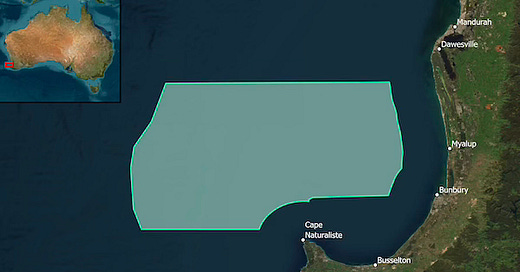The catastrophic COVID-19 policies showed us that most Western governments have no qualms about forcing their agenda upon the populace, even if it means the suppression of civil liberties and coercion of people to get them to do what they want. A similar thing is happening with the climate change hysteria, and don't you dare complain.
I live in a beautiful part of the world, an hour south of Perth, West Australia. We are blessed with a lovely Mediterranean climate. We experience warm to hot summers with 300 days of sunshine a year. Most summer days, in the afternoon, we get a sea breeze that soothes the day's heat. This part of the world is also very windy. Our winters are cooler, but even during winter, there are few days where we never see the sun. In the winter, we can have gales that roar off the ocean––we have clocked 120 kilometres per hour winds a few times.
This part of the world has a low population density. The sandy beaches make you feel as if you are blessed with your own private beach. We are also close enough to amenities where we don't feel isolated from the trappings of our modern world. If you want wildlife here, there is plenty around with Kangaroos, Dolphins, Quendas, Pelicans, plenty of rabbits, and oh yes, the odd snake.
In light of all this, solar energy systems make sense. The majority of the homes here have solar panels on their rooftops. Unfortunately, most of these are produced in China. Perhaps even worse, the government subsidizes the cost of installing solar panels. So, we subsidize Chinese workers, not our own.
Wind power also makes sense; the problem is, how much of the environment do you want to deface to get to a carbon-neutral world if you believe the prevailing narrative that carbon is a pollutant. On the contrary, carbon is essential to life, so how it became a pollutant is bizarre.
Huge 1,100MW offshore wind farm proposed in W.A. by oil explorer
The proposed wind farm will have over 100 metres high wind turbines and be 8600 square kilometres in the area! How many realize this proposed wind farm will cover a large swath of our ocean?
There is not even a consideration of nuclear power in Australia, a technology available for many decades. The largest nuclear power plants emit zero pollution; they occupy a small amount of real estate. The largest one in the world, which takes up 4 square kilometres, puts out eight times the output of this 1,100 megawatt wind farm being proposed. Based on other wind farms, the one planned on our coast will likely have at least 100 turbines.
Interestingly, one of the rationales for this wind farm is that it will create jobs. Do they mean the same jobs created by the construction of solar panels? Oops, wrong country––China,
Of course, the overriding rationale is that the planet is burning up, and if we don't get to net zero, well, you know the drill. Climate change has permeated every aspect of society: government departments, industry, the classroom, medicine, and even…racism. The illogical has become logical.
The other day, took my Ford sedan to have the battery replaced. I perused the showroom and counted eight vehicles on display, but not one sedan. The smallest was a medium-sized SUV—with less space than my sedan—while the rest were pickups and large SUVs, including a couple of $100,000 plus Raptors. So the vehicles are getting larger, but we're in a climate crisis.
I was told by the Ford employee in the showroom that sedans are a thing of the past. There is a disconnect with the government's plans to eliminate gas-powered vehicles within 10 years, whether we like it or not. Yet, Ford and other automakers are building larger vehicles, which consume more resources and presumably emit more greenhouse gases in their construction.
I'll hang on to my nice running sedan with its 90,000 kilometres and my zippy sports car. After that, I may have to rely on my bike. I'll be accused of exerting myself too much and emitting too much CO2. But wait, there is now a study stating that.
Study Finds Humans Are Contributing To Global Warming By Breathing
Well, we all know humans who are full of hot air. Still, seriously, the hysteria about climate change or global warming has gone over the top.








Carbon Dioxide
Ian Plymer (a very well respected Australian geologist), in his seminal work ‘Heaven + Earth’ discusses the history of planet Earth and the variations in carbon dioxide over 4.5 billion years. Some quotes will come from this book. Obviously, dependable data decreases as one goes into the past. However, I believe that the current story on global warming and carbon dioxide is total misinformation at its very worst (apart from the stupidities over the last three years with COVID).
Let me try to give you a few facts drawn from the historical and geological records. Only a couple of thousand years ago, the Greeks and the Romans were wearing light cotton fabrics (the so-called Roman Warming period from c.250BC to c.450AD, Plymer, page 59). Further back “the last 2.67my has been a time of cyclical icehouse and greenhouse conditions” (Plymer, page 34). He goes on to say that over the last 730,000 years there have been ten major global glaciations and interglacials which appear to be related heat exchange processes between ice and ocean, not CO2.
Overall, periods of climatic warming have lead to improvements in food, wealth, social stability and rapid diversification of life on Earth. Plymer (page 32) points out that “history and archeology show us that global cooling results in drought, social disruption, climate refugees, famine, disease war, depopulation collapse of civilisations, and extinction of plants and animals”.
On a geological scale, warming in the Cambrian and the Carboniferous exhibited unprecedented proliferation of animals, and in the latter, plants (eg, coal swamps).
These are just small glimpses into Plymer’s excellent book. Another book worth reading is ‘Winters of the World’, edited by Brian John. This again debunks the idea that carbon dioxide is complicit in any global warming causality. It only occupies 0.03% of the Earth’s atmosphere, as opposed to the massive amount of water vapour.
I worked internationally for 27 years as an exploration sedimentary geologist. What prompted me to write all this was the article below. The perpetuation of this carbon myth is precisely that. Bear in mind one last fact - human bodies are composed of 17-23% carbon ! Also, that many of the temperature recording stations are now moribund and are sited in the industrial northern hemisphere. It is the noxious gases emanating from our societies, and other real pollutants like plastic that we should be eradicating.
Sincerely, MartinWhite (Western Australia)
Story at-a-glance
Carbon dioxide (CO2) is commonly mischaracterized as a harmful waste product of respiration and is falsely blamed for disrupting the planetary climate
CO2 is an essential gas necessary for life. Moreover, its impact on Earth’s temperatures is negligible, and will remain negligible even if the current concentration in the atmosphere were to double. A 100% increase of CO2, from 400 ppm to 800 ppm, would decrease radiation into space by just 1.1%, resulting in a 0.7 degree C increase of the average earth temperature
A 0.7 degree C difference means there’s no climate emergency, and no matter what we do to reduce CO2 emissions, it’s not going to impact global temperatures. To fabricate an emergency where there is none, it is assumed that massive positive feedbacks are involved. However, most natural feedbacks are negative, not positive, so isn’t it likely the 0.7 degree C increase is an overestimation to begin with
There’s no single temperature of the Earth. It varies by location and altitude. For every kilometer of altitude, you have an average cooling of 6.6 degrees C
Higher CO2 levels will green the planet, making it more hospitable to plant life. The more CO2 there is, the better plants and trees grow. CO2 also reduces the water needs of plants, reducing the risks associated with droughts
The video above, “CO2, The Gas of Life,” features a lecture given at the Summit Old Guard Meeting in New Jersey, October 3, 2023, by William Happer, Ph.D., Professor Emeritus of physics at Princeton University and former scientific adviser to the Bush and Trump administrations.
The topic: carbon dioxide (CO2), commonly mischaracterized as a harmful waste product of respiration and a pollutant that is disrupting the planetary climate. As explained by Happer in this lecture, CO2 is actually an essential gas necessary for life. Moreover, its impact on Earth’s temperatures is negligible, and will remain negligible even if the current concentration in the atmosphere were to double.
CO2 Is Not a Pollutant
At present, the CO2 concentration in the atmosphere at a few thousand feet of elevation is around 430 parts per million (ppm). Closer to the ground, concentrations vary widely, both by location and time of day. This is because ground-level readings are impacted by photosynthesis and the respiration of insects and the like.
In the room where Happer was giving his lecture, the CO2 reading was 1,800 ppm — the result of having a large group of people breathing in a closed space. Air conditioning systems have CO2 meters that turn on fans to bring outdoor air inside when levels get too high.
The question of what is too high is an important one, considering The Great Resetters are pushing a green agenda that demands the dismantling of energy infrastructure and farming in the name of stopping climate change, which quite obviously threatens our quality of life and food supply. Ultimately, it may threaten human existence altogether.
The fact of the matter is that CO2 is not the “bad guy” it’s made out to be, and the “net zero” agenda is wholly inappropriate if maintaining life on Earth is part of the equation.
“CO2 is a very essential and natural part of life,” Happer says. “It is the gas of life. We’re made of carbon after all, mostly carbon, and we breathe out a lot of CO2 a day just by living. Each of us breathes out about 2 pounds of CO2 a day. Multiply that by 8 billion people and 365 days a year, and just [by] living, people are a non-negligible part of the CO2 budget of the Earth.
Nevertheless, we are living through a crusade against so-called pollutant CO2. People talk about carbon pollution. [But] every one of us is polluting Earth by breathing, [so] if you want to stop polluting ... apparently God wants us to commit suicide ...
We're doing all sorts of crazy things because of this alleged pollutant ... more and more beautiful meadows are being covered with black solar panels. It doesn't work very well; it doesn't work at all at night. It doesn't work on cloudy days. It doesn't work terribly well in the middle of the winter because of the angle of the sun.
But nevertheless we're doing it. We’re being misled into climate hysteria, and if you haven't read this book, I highly recommend it. It was published first in 1841, called ‘Extraordinary Popular Delusions and the Madness of Crowds.’ It’s as relevant today as it was then ...
I'm a physicist. I'm proud to say that no one could call me a climate scientist, but I know a lot about climate and I was a coauthor of one of the first books on the effects of carbon dioxide 41 years ago. This was a study done by the Jason Group which I was a member of. I was chairman for a while and it had really good people there.”
Long-Term Impact of Increasing Atmospheric CO2
The key question when it comes to global warming is, how much do you warm the Earth if you double the atmospheric CO2 concentration? This is called the climate sensitivity question. The GUESS is that doubling CO2 would result in a 3-degree centigrade rise in the global temperature.
“It was not based on any hard calculations,” Happer says. “It was because of group-think. That's what everybody else thought, and so that's what we thought.